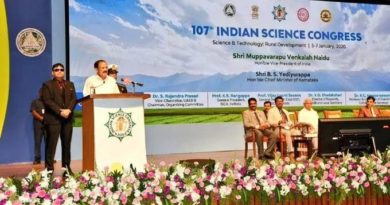DESPITE Calculated Risk, ISRO Is Planning To Land Chandrayaan 11 On Moon, says ISRO Chief
BENGALURU headquartered Indian Space Research Organization is going ahead to send human for the first time in space by 2022 while its ambitious project Chandrayaan 2 will be completed in 2019 with Landing of an indigenous spacecraft. This was confirmed by ISRO’s Chairman Kailasavadivoo Sivan at Gokharakhpur in Uttar Pradesh. Answering query by media. Ivan, who was in the ancient city close to India-Nepal border to attend the convocation ceremony of DDU Gorakhpur University .”We have set a deadline of sending human to space by the end of 2021 or beginning of 2022″.The Chandrayaan 2 will be sent on the moon by January or February next year. Chandrayaan 2 is designed to make soft landing on the moon and carry out extensive experiments on its surface. Scientists at the Indian Space Research Organisation (ISRO) will undertake three to six missions in the next six months.The ISRO is serving the nation in various fields including improving communication, navigation, space science etc and every single person of India is somehow linked with its services, he said.”Under Digital India Mission launched by Prime Minister Narendra Modi, the ISRO is all set to provide high data connectivity of 100 GBPS in rural and remote areas by placing four communication satellites on the space, One of these,is already placed this year. The rest three will be placed in November- December and early next year,” he said. He said more than 75 per cent of the population of India country lives in remote areas and it is advisable to space technology to provide services in various speeds. The ISRO chairman said although it was not possible for India’s premier space agency to recruit all potential engineers passing out from Indian universities yet it was working on capacity building programmes to tab their potential through incubation and research centres.”The ISRO will provide opportunities to young engineers to serve the nation by opening six incubation centres, research centres and research chair in north, south, east, central and west India,” he said.While one incubation centre has been opened in Agartala, rest will operationalise in Jalandhar, Bhubaneswar, Indore, Nagpur and Kochi. Similarly, research centres would come up in Guwahati, Jaipur, Kurukshetra, Kanyakumari, Patna and Varanasi, he added.Speaking at the ninth convocation of GITAM Deemed to be University at Rudraram in neighbouring Sangareddy district on September 23, Sivan said though half of the lunar missions have failed, ISRO is taking a calculated risk, because calculated risk along with innovation is absolutely essential if we want to be a major player in the space industry. Chandrayaan 2 is also a calculated risk,” he said. The landing site at the Moon is above 70- degree latitude, “where no one else has gone before”, he said. India has not only developed launch vehicles and satellites but also undertaken extremely challenging and inspiring missions like Chandrayaan, Mars Orbiter Mission and Astrosat, he says.




